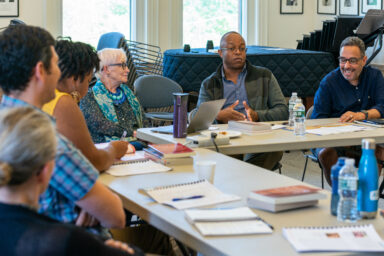Background
On-the-job work experiences are essential for developing students’ interest in future education and careers, as well as their hard and soft career skills. Capable mentors appear to be particularly important components of these experiences, and may mediate or moderate the effects of work placement and training. Internships and the mentoring experiences they include may be especially important for developing the interests and careers of under-served students.5,6 However, to date few studies have explored the connection between summer high school internship experiences and student outcomes among under-served students,2 and those that have are typically focused on the effects of STEM internships.
Purpose/Research Question
The purpose of the current study is to examine whether the impacts observed in previous studies of STEM internships extend to an internship focused on arts and culture. Toward this end, researchers worked with the Bloomberg Arts Internship (BAI), an intensive, 6-week program designed to expand participation by under-served students in the arts and culture sector. Researchers employed a randomized control design to address two research questions:
- What is the impact of the internship on students’ learner mindsets, preparation for further education and career, and cultural engagement?
- How does the quality of mentoring and supervision promote or constrain these impacts?
Setting
BAI was offered to rising junior high school students in Baltimore City Schools, Boston Public Schools, New York City Schools, and Philadelphia Public Schools systems.
Population/Participants/Subjects
445 high school students from Baltimore City School, Boston Public School, New York City School, or Philadelphia Public School systems participated in BAI over the course of three cohorts: 2018, 2019, and 2020. Demographic data for the cohorts is presented in Table 1. A large majority of students identified as persons of color (86.4%) and over half of students indicated that they spoke a language at home other than English (51.0%).
Intervention/Program/Practice
BAI consists of an intensive six-week, paid internship placement (six hours per day, five days per week), supplementary classroom sessions to develop communication and career technical skills, and onsite visits to local arts organizations. As part of the internship program, students were assigned a mentor at their host organization who was typically a recent high school graduate currently enrolled in college. Students also had a supervisor who was an employee at the host organization.
Research Design
The study design is a randomized control design (RCD). Researchers randomly assigned students to a control group that completed core pre- and post-measures over a six-week period just prior to the arts internship or a treatment group that completed the same measures immediately before and at the end of the arts internship.
Data Collection and Analysis
The present study used data collected from the BAI application and pre-post student surveys. The BAI application collected students’ demographic information and current experience with the arts. The student survey assessed students’ learner mindsets, preparation for further education and career, and cultural engagement. Specifically, for learner mindset researchers measured future orientation, general self-concept, and growth mindset; for preparation for further education and careers researchers assessed students’ feelings of preparedness about attending college, vocational training, or getting a job; for cultural engagement, researchers measured students’ interest in arts careers, knowledge of arts careers, excitement about the arts, and knowledge of the arts in students’ cities. In addition, the post-internship student survey asked students to reflect on the quality of the mentoring they received.
Findings/Results
Overall, BAI had a positive impact on students’ learner mindsets, preparation for further education and career, and cultural engagement. On learner mindset measures, BAI students exhibited a significant increase in their future orientation and general self-concept across all three cohorts (3.2 percent and 5.2 percent, respectively), though similar increases were not observed for growth mindset. On preparation for further education and careers measures, students’ reported large significant differences in their sense of preparedness to pursue college, vocational training, or a job. Relative to baseline, BAI students reported a 14.4 percent increase with respect to pursuing college, 27.2 percent with respect to pursuing vocational training, and 7.4 percent with respect to getting a job. All three changes were statistically significant. Finally, on cultural engagement measures, BAI students reported a 13.5 percent increase in knowledge of arts careers and 19.5 percent increase in knowledge about the arts in their cities. No statistically significant results were exhibited for BAI students on interest in arts careers or excitement about arts careers.
BAI students completed their student surveys before and upon completion of their six-week internship. Thus, it was possible to examine how preparation for future education and career and cultural engagement were associated with the quality of mentoring students felt they received. There were strong associations between higher-quality mentoring and larger increases in students’ preparation for attending college, pursuing vocational training, or getting a job. Similarly, as the reported quality of mentoring increased, so too did students’ knowledge of arts careers and knowledge of arts in their cities. Of particular note is the fact that for some domains the association between quality of mentoring and program effects was essentially linear (e.g., preparation for getting a job), while for others (e.g., knowledge of arts in the city) a threshold effect was observed.
Conclusions
Participation in BAI yielded positive effects on under-served high school students’ learner mindsets, preparation for future education and careers, and cultural engagement (research question 1). Moreover, the quality of mentoring and supervision promoted these effects, particularly with regard to preparation for attending college, pursuing vocational training, or getting a job, and students’ knowledge of arts careers and arts in their cities (research question 2). Although investigations into the long-term effects of the program are ongoing, we may conclude that an arts and culture internship yields benefits to under-served students, raising the question of whether replicating the program to serve more students in more cities may be one way to promote greater equality of educational opportunities.




